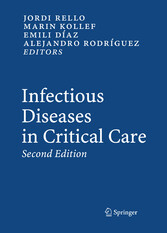Suchen und Finden
"35 Tracheobronchitis in the Intensive Care Unit (p. 385-386)
L. Morrow, D. Schuller
35.1 Introduction
Tracheobronchitis can be broadly defined as inflammation of the airways between the larynx and the bronchioles. Clinically, this syndrome is recognized by an increase in the volume and purulence of the lower respiratory tract secretions and is frequently associated with signs of variable airflow obstruction. In the intensive care unit (ICU), tracheobronchitis is a relatively common problem with an incidence as high as 10.6% [1]. Although tracheobronchitis is associated with a significantly longer length of ICU stay and a prolonged need for mechanical ventilation, it has not been shown to increase mortality.
These outcomes can be improved through the use of antimicrobial agents [1]. Tracheobronchitis results fromtwo dominating processes: colonization of the oropharynx and its contiguous structures (dental plaque, the sinuses, the stomach) by potentially pathogenic organisms and aspiration of contaminated secretions from these anatomic sites [2]. Mechanically ventilated patients are particularly at risk for tracheobronchitis given the presence of an endotracheal tube.
These devices contribute to the pathogenesis of tracheobronchitis (and pneumonia) in a variety of manners: bypassing natural host defenses, acting as a nidus for biofilm formation, allowing pooled secretions and bacteria to leak around the cuff and into the trachea, damaging the ciliated epithelium and reducing bacterial clearance directly or via frequent suctioning to maintain airway patency [3, 4]. In contrast to nosocomial pneumonia, nosocomial tracheobronchitis does not involve pulmonary parenchyma and, thus, does not cause radiographic pulmonary infiltrates. However, high quality portable chest radiographs may be difficult to obtain in the ICU, where poor patient cooperation, inconsistent technique and other obstacles lead to suboptimal studies [5].
Furthermore, common processes such as atelectasis, pulmonary edema, or pleural effusions can cause infiltrates that mimic pneumonia making the clinical distinction between pneumonia and tracheobronchitis difficult [6].
35.2 Bacterial Tracheobronchitis
Bacterial infection is the most common cause of infectious tracheobronchitis in the ICU. Infectious tracheobronchitis is clinically diagnosed when a patient develops fever, purulent respiratory secretions, and leukocytosis but the chest radiograph shows no new infiltrate [7]. Tracheobronchitis is “microbiologically confirmed” when a patient with clinically diagnosed tracheobronchitis yields culture specimens that identify a causative pathogen at appropriately high densities.
When a patient lacks fever or leukocytosis (or if culture specimens reveal few organisms) the differentiation between colonization and infection is difficult and controversial. Furthermore, the significance of tracheobronchial colonization as a risk factor for subsequent lower respiratory tract infection remains unclear.
Alterations in the oropharyngeal flora of the hospitalized host have been associated with several factors including age, severity of acute illness, comorbid chronic illnesses, and duration of hospitalization [8–10]. One study of outpatients with chronic tracheostomy concluded that although these patients were routinely colonized with massive amounts of potentially pathogenic bacteria, rates of severe respiratory tract infections were low [11]."
Alle Preise verstehen sich inklusive der gesetzlichen MwSt.








